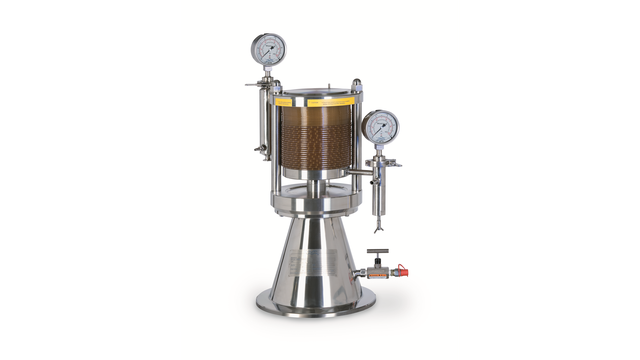LabStak
Alfa Laval offers a wide range of small-scale LabStak modules which are ideal for on-site testing. Valuable data is gained for evaluation of process feasibility, determination of design and up-scaling, optimization of existing production lines or processing of high-value products.
Small-scale LabStak® modules
In order to ensure the optimum solution, it is often advisable to conduct experiments on a small scale. These can be used to establish process feasibility, determine design data for up-scaling, optimize existing production lines or even carry out small-scale processing of high-value and/or low-volume products.
Our range of LabStak® modules is based on the unique plate-and-frame design with the module sizes: M10, M20, M37, M38 and M39. The liquid capacity of our LabStak® modules varies from only 57 ml of test media volume in the Alfa Laval LabStak® M10 module up to 3 litres in the Alfa Laval LabStak® M39H module. It is possible to test all filtration processes: Reverse osmosis, nanofitration, ultrafiltration and microfiltration.
For the Alfa Laval LabStak® M20 module we offer the possibility to test also spiral wound membranes as the module can be equipped with a specially designed M20-2.5" housing. This makes it a perfect tool for initial spiral element testing before screening on flat sheet membranes.
On-site testing or at Alfa Laval pilot facilities
Alfa Laval provides small-scale modules, units and pilot plants for testing on-site in connection with other process equipment and for testing at our own state-of-the-art Membrane and Application Development Test Centre in Nakskov, Denmark. In both cases, we also provide highly skilled process consultancy services.
Benefits
- You can make the first screening evaluations in your own laboratory and thus get the correct answers to vital questions
- The same design is used for both small-scale and industrial scale equipment which allows you to develop new processes and products
- The data gathered is accurate and reliable for easy up-scaling
- Alfa Laval has its own membrane and application development test centre where experts are ready to help you with process know-how and test work
- You can conduct experiments with both plate-and-frame and spiral wound module configurations - and all filtration processes
Membran filtrasyonu nasıl çalışır?
Fiziksel separasyon
Membran filtrasyonu, itici gücün özel bir membranın iki tarafı arasındaki basınç farkı olduğu fiziksel bir ayırma işlemidir. Bu işlem, farklı boyut ve özelliklerdeki molekülleri seperasyon yeteneği ile karakterize edilir. Hemen hemen tüm endüstriyel membran filtrasyonu, filtrelenen sıvının membrana paralel olarak yüksek hızda ve basınç altında aktığı çapraz akışlı filtrasyon olarak gerçekleştirilir
Fiziksel bariyer
En temel ifadeyle, membran filtrasyonu, tek bir besleme akışının, onu süzüntü ve retentat olarak bilinen iki ayrı akışa ayıran bir membran sisteminden geçirilmesini içerir. Bunları ayıran membran, son derece özel özelliklere sahip fiziksel bir bariyerdir - besleme akışında yalnızca belirli seçilmiş bileşenlerin geçebileceği bir bariyer.
Passing through
Bu tür membran malzemesinin gözenekleri o kadar küçüktür ki, Angstrom (10-10 m) cinsinden ölçülürler ve sıvıyı içlerinden geçirmek için basınç gerekir. Aslında, nanofiltrasyon ve ters ozmoz için kullanılan membranlardaki gözenekler o kadar küçüktür ki, taramalı elektron mikroskobu ile bile görülemez.
Long experience with membranes
Alfa Laval's experience within membrane filtration dates back almost as far as the technology itself, and we wish to share our experience with you.

